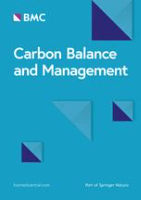
Carbon Balance and Management
Scope & Guideline
Empowering global change through impactful research.
Introduction
Aims and Scopes
- Carbon Sequestration and Storage:
Research aimed at understanding and enhancing the processes of carbon sequestration in various ecosystems, including forests, wetlands, and agricultural lands. This includes studies on biomass, soil carbon stocks, and the role of different land management practices. - Carbon Emission Accounting:
Development of methodologies for accurate accounting of carbon emissions from different sectors, including agriculture, forestry, and urban environments. This encompasses the analysis of greenhouse gas (GHG) emissions and the establishment of emission factors. - Impact of Climate Change:
Investigating how climate change influences carbon dynamics, including changes in carbon stocks, fluxes, and the resilience of ecosystems. This area also includes studies on the effects of extreme weather events on carbon balance. - Sustainable Land Management:
Exploration of practices that promote sustainable land use while maximizing carbon storage and minimizing emissions. This includes agroforestry, conservation agriculture, and forest management strategies. - Remote Sensing and Modeling:
Utilization of advanced technologies, such as remote sensing and modeling approaches, to assess carbon stocks and fluxes across large spatial scales. This includes the application of satellite data and process-based models. - Policy and Governance:
Examination of the role of policy frameworks and governance structures in facilitating effective carbon management strategies, including international agreements and national-level policies.
Trending and Emerging
- Integration of Social and Environmental Factors:
There is a rising trend in research that integrates social dimensions with ecological factors in carbon management, emphasizing the importance of community involvement, socio-economic impacts, and the role of local governance. - Innovative Carbon Accounting Techniques:
New methodologies for carbon accounting, including the use of remote sensing and advanced modeling techniques, are becoming increasingly prominent, reflecting the need for more accurate and scalable approaches to measure carbon dynamics. - Soil and Microbial Interactions:
Emerging studies focus on the interplay between soil health, microbial communities, and carbon storage. This trend underscores the importance of biophysical processes in enhancing soil carbon sequestration. - Climate Resilience Strategies:
Research geared toward developing and implementing climate resilience strategies that incorporate carbon management as a key component is gaining traction, reflecting the urgency to address climate change impacts. - Carbon Farming and Economic Viability:
The concept of carbon farming, which integrates carbon management into agricultural practices for economic benefits, is becoming a focal point. This includes assessments of cost-effectiveness and potential market mechanisms for carbon credits.
Declining or Waning
- Traditional Forestry Practices:
Research focusing solely on conventional forestry practices without considering modern approaches to carbon management is becoming less common. The increasing emphasis on innovative and integrated land management practices has overshadowed traditional methodologies. - Local Case Studies:
While localized studies have been valuable, there is a noticeable decline in the number of papers focusing on specific regional case studies as researchers increasingly aim for broader, more global perspectives on carbon dynamics. - Historical Carbon Stock Analysis:
The focus on retrospective analysis of historical carbon stocks is waning as the field shifts toward predictive modeling and future scenarios that can inform current and upcoming carbon management strategies. - Basic Soil Carbon Measurements:
Simple soil carbon measurement studies are less frequently published, as the field evolves to include more complex analyses that consider interactions with microbial communities, land use changes, and environmental factors.
Similar Journals
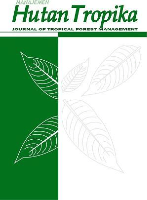
Jurnal Manajemen Hutan Tropika
Empowering ecological understanding through open access.Jurnal Manajemen Hutan Tropika, with ISSN 2087-0469 and E-ISSN 2089-2063, is an esteemed academic journal published by the Bogor Agricultural University, Faculty of Forestry in Indonesia. Since its inception in 1999 as an Open Access journal, it has been dedicated to advancing knowledge in the fields of ecology, forestry, and related environmental sciences. Aiming to provide a robust platform for disseminating research, it has achieved notable rankings within Scopus, including a Q3 classification in Ecology and Ecology Evolution, as well as a Q2 ranking in Forestry for 2023. The journal's commitment to open access ensures that vital research findings are readily available to researchers, professionals, and students alike, fostering collaboration and innovation in tropical forest management. Located at KAMPUS IPB DARMAGA, BOGOR, JAWA BARAT, this journal continues to be a significant resource for enhancing sustainable forest practices and contributing to ecological understanding in the region and beyond.

Trees Forests and People
Advancing Knowledge for Sustainable Forest ManagementTrees, Forests and People is an esteemed peer-reviewed journal published by Elsevier that commenced its journey in 2020 and focuses on the intricate relationships between trees, forests, and human communities. With its E-ISSN of 2666-7193, this journal serves as a vital platform for presenting cutting-edge research in disciplines such as forestry, environmental science, and management. Recognized for its impact within the academic community, it has achieved a prestigious Q1 ranking in both Economics, Econometrics and Finance (Miscellaneous) and Forestry, alongside a Q2 ranking in Management, Monitoring, Policy and Law as of 2023. Its Scopus rankings indicate robust positioning in various fields, appealing to a diverse audience of researchers, professionals, and policy-makers engaged in sustainable forest management and ecosystem services. By offering open access options, the journal ensures that critical findings are readily available to a global audience, fostering knowledge sharing and collaborative efforts aimed at addressing the pressing challenges in forest conservation and management.

BOIS ET FORETS DES TROPIQUES
Illuminating the Richness of Tropical ForestsBOIS ET FORETS DES TROPIQUES is a distinguished journal published by CIRAD-CENTRE COOPERATION INT RECHERCHE AGRONOMIQUE POUR, based in France. The journal is committed to disseminating high-quality research in the domains of ecology, forestry, and environmental science, reflected by its impressive ranking in multiple Scopus categories, including Q2 in Forestry and Q3 in Ecology. With an ISSN of 0006-579X and an e-ISSN of 1777-5760, BOIS ET FORETS DES TROPIQUES serves as a vital platform for scholars and practitioners to explore and share insights about tropical forests and their ecosystems. Although it operates under a subscription model without open access options, the journal plays a crucial role in advancing research and practices essential for sustainable forest management and biodiversity conservation in tropical regions. Its ongoing publication from 2010 to 2024 ensures a continuous contribution to the academic community, fostering a deeper understanding of ecological dynamics and promoting innovative approaches within the field.
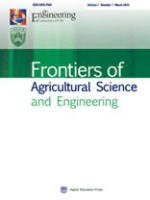
Frontiers of Agricultural Science and Engineering
Advancing agricultural innovation for a sustainable future.Frontiers of Agricultural Science and Engineering, published by HIGHER EDUCATION PRESS, is a distinguished open-access journal established in 2014, dedicated to advancing research across the fields of agricultural and biological sciences, biotechnology, and veterinary studies. With an impressive Q1 ranking in both Agricultural and Biological Sciences and Veterinary categories for 2023, this journal positions itself prominently within the academic landscape, reflecting the importance and quality of the research it disseminates. The journal serves as a vital platform for researchers, professionals, and students worldwide, featuring a broad array of studies that enhance our understanding of agricultural technologies, biotechnological innovations, and veterinary sciences. With a focus on rigor and accessibility, Frontiers of Agricultural Science and Engineering promotes the global exchange of knowledge, encouraging the collaboration that is essential for tackling contemporary challenges in these critical fields. Available online with a comprehensive range of article options, it continues to contribute to the scientific community's advancements in agricultural and biological disciplines.
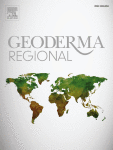
Geoderma Regional
Innovating research at the intersection of agriculture and biology.Geoderma Regional is a premier scholarly journal dedicated to advancing the field of Soil Science. Published by Elsevier in the Netherlands, this journal serves as a vital platform for disseminating high-quality, peer-reviewed research that spans the complexities of soil management, behavior, and the implications of soil processes on environmental sustainability. Since its inception in 2014, Geoderma Regional has achieved an impressive position within the academic community, holding a Q1 ranking in the field of Soil Science, placing it among the top 20% of journals in its category according to SCOPUS rankings. This journal is particularly distinguished for its significant contributions to the nexus between agriculture and biological sciences, reflected in its rank of #33 out of 159 in this field with a commendable 79th percentile. Researchers, professionals, and students alike will appreciate the journal's commitment to open discourse and innovative research agendas as it aspires to enhance our understanding of soil dynamics, addressing critical issues facing our planet.

Frontiers in Forests and Global Change
Connecting researchers to combat environmental crises.Frontiers in Forests and Global Change is a leading open-access journal dedicated to advancing research in the interdisciplinary fields of forests, ecology, and global environmental change. Published by FRONTIERS MEDIA SA in Switzerland, this journal has established itself as a vital resource for scholars in ecological and environmental science, securing a prestigious Q1 ranking in multiple categories such as Ecology and Forestry as of 2023. With its commitment to open access since 2018, Frontiers in Forests and Global Change facilitates the widespread dissemination of knowledge and fosters global collaboration among researchers, professionals, and students aiming to address pressing environmental issues. The journal's emphasis on innovative research aligns with its aim to tackle the complexities of climate change and its impact on forest ecosystems, making it an essential publication for those seeking to contribute to sustainable solutions for our planet.
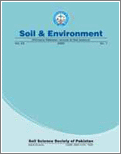
Soil & Environment
Empowering Knowledge for Sustainable Soil ManagementSoil & Environment is a distinguished open access journal published by the University of Agriculture, Institute of Soil & Environmental Sciences, located in Faisalabad, Pakistan. Established in 2006, this journal has become a vital platform for disseminating pioneering research in the fields of Environmental Science and Soil Science. With an ISSN of 2074-9546, it provides a wealth of knowledge through accessible academic articles, particularly focusing on sustainable practices and innovations that impact soil and environmental health. Although currently categorized in Q4 within both Environmental Science (miscellaneous) and Soil Science, the journal is dedicated to enhancing its influence and visibility as it progresses towards convergence years that span from 2010 to 2024. Researchers, professionals, and students will find Soil & Environment an essential resource for staying informed about the latest developments and methodologies in soil conservation and environmental sustainability. By offering publicly accessible content, the journal aims to foster greater collaboration and knowledge-sharing within the global scientific community.
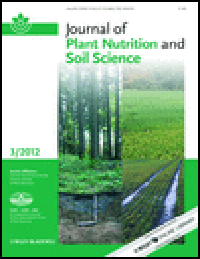
JOURNAL OF PLANT NUTRITION AND SOIL SCIENCE
Connecting science and practice for a sustainable tomorrow.JOURNAL OF PLANT NUTRITION AND SOIL SCIENCE, published by WILEY-V C H VERLAG GMBH, stands as a premier platform in the field of agricultural and biological sciences, focusing specifically on the intricacies of plant nutrition and soil science. With an impressive impact factor and a respected Q1 category ranking in Plant Science and Q2 category ranking in Soil Science for 2023, this journal is essential for researchers and professionals seeking to advance their understanding and foster innovative practices in sustainable agriculture. The journal’s open access options ensure a broad dissemination of knowledge, appealing to a global audience and facilitating collaborative research efforts. Embracing a broad scope that extends from foundational science to cutting-edge research developments in soil health and nutrient management, the journal serves as a critical resource for both emerging scholars and established experts, reinforcing its pivotal role in addressing the challenges of food security and environmental sustainability. With years of convergence from 1996 to 2024, it remains committed to excellence in scholarly communication, providing a vital forum for the sharing of valuable insights and advancements in the field.
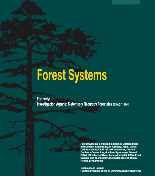
Forest Systems
Connecting research with practice in forest management and conservation.Forest Systems, an esteemed open-access journal published by CONSEJO SUPERIOR INVESTIGACIONES CIENTIFICAS-CSIC in Spain, has been a dedicated platform for advancing knowledge in the fields of ecology, forestry, and soil science since its inception in 1991. With an ISSN of 2171-5068 and E-ISSN 2171-9845, the journal is committed to disseminating high-quality research that addresses critical issues related to forest ecosystems and their management. Forest Systems is positioned within the Q4 category in Ecology, Evolution, Behavior and Systematics, and Q3 in both Forestry and Soil Science, evidencing its growing influence and relevance in these disciplines. Researchers will find a rich repository of articles that not only contribute significantly to academic discourse but also foster practical solutions to contemporary environmental challenges. As it converges from 2010 to 2024, the journal aims to enhance its outreach and impact, facilitating access for professionals, students, and policymakers committed to sustainable forest management and ecological conservation.

AGROFORESTRY SYSTEMS
Transforming agricultural landscapes with science and sustainability.AGROFORESTRY SYSTEMS, published by Springer, is a leading journal in the fields of Agronomy and Crop Science and Forestry. With an impressive impact factor and prestigious rankings—Q2 in Agronomy and Crop Science and Q1 in Forestry as of 2023—this journal occupies a vital niche in publishing high-quality research that intersects agricultural practices and forest management. The journal aims to advance the understanding of agroforestry practices, promoting sustainable land use and enhancing ecosystems worldwide. Operating since 1982, AGROFORESTRY SYSTEMS stands out with its rigorous peer-review process, ensuring the dissemination of significant scientific findings that contribute to both theoretical insights and practical applications. Although it does not currently offer open access, the journal continues to be accessible through various academic platforms, supporting researchers, professionals, and students in their pursuit of knowledge within this dynamic field.